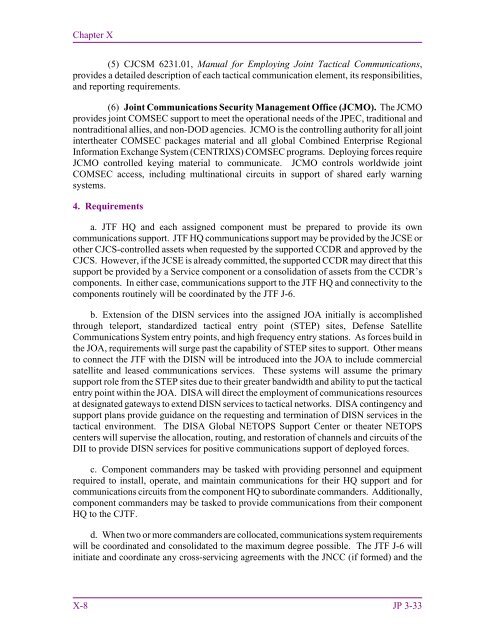JP 3-33, Joint Task Force Headquarters - Defense Innovation ...
JP 3-33, Joint Task Force Headquarters - Defense Innovation ...
JP 3-33, Joint Task Force Headquarters - Defense Innovation ...
You also want an ePaper? Increase the reach of your titles
YUMPU automatically turns print PDFs into web optimized ePapers that Google loves.
Chapter X<br />
(5) CJCSM 6231.01, Manual for Employing <strong>Joint</strong> Tactical Communications,<br />
provides a detailed description of each tactical communication element, its responsibilities,<br />
and reporting requirements.<br />
(6) <strong>Joint</strong> Communications Security Management Office (JCMO). The JCMO<br />
provides joint COMSEC support to meet the operational needs of the <strong>JP</strong>EC, traditional and<br />
nontraditional allies, and non-DOD agencies. JCMO is the controlling authority for all joint<br />
intertheater COMSEC packages material and all global Combined Enterprise Regional<br />
Information Exchange System (CENTRIXS) COMSEC programs. Deploying forces require<br />
JCMO controlled keying material to communicate. JCMO controls worldwide joint<br />
COMSEC access, including multinational circuits in support of shared early warning<br />
systems.<br />
4. Requirements<br />
a. JTF HQ and each assigned component must be prepared to provide its own<br />
communications support. JTF HQ communications support may be provided by the JCSE or<br />
other CJCS-controlled assets when requested by the supported CCDR and approved by the<br />
CJCS. However, if the JCSE is already committed, the supported CCDR may direct that this<br />
support be provided by a Service component or a consolidation of assets from the CCDR’s<br />
components. In either case, communications support to the JTF HQ and connectivity to the<br />
components routinely will be coordinated by the JTF J-6.<br />
b. Extension of the DISN services into the assigned JOA initially is accomplished<br />
through teleport, standardized tactical entry point (STEP) sites, <strong>Defense</strong> Satellite<br />
Communications System entry points, and high frequency entry stations. As forces build in<br />
the JOA, requirements will surge past the capability of STEP sites to support. Other means<br />
to connect the JTF with the DISN will be introduced into the JOA to include commercial<br />
satellite and leased communications services. These systems will assume the primary<br />
support role from the STEP sites due to their greater bandwidth and ability to put the tactical<br />
entry point within the JOA. DISA will direct the employment of communications resources<br />
at designated gateways to extend DISN services to tactical networks. DISA contingency and<br />
support plans provide guidance on the requesting and termination of DISN services in the<br />
tactical environment. The DISA Global NETOPS Support Center or theater NETOPS<br />
centers will supervise the allocation, routing, and restoration of channels and circuits of the<br />
DII to provide DISN services for positive communications support of deployed forces.<br />
c. Component commanders may be tasked with providing personnel and equipment<br />
required to install, operate, and maintain communications for their HQ support and for<br />
communications circuits from the component HQ to subordinate commanders. Additionally,<br />
component commanders may be tasked to provide communications from their component<br />
HQ to the CJTF.<br />
d. When two or more commanders are collocated, communications system requirements<br />
will be coordinated and consolidated to the maximum degree possible. The JTF J-6 will<br />
initiate and coordinate any cross-servicing agreements with the JNCC (if formed) and the<br />
X-8 <strong>JP</strong> 3-<strong>33</strong>

















